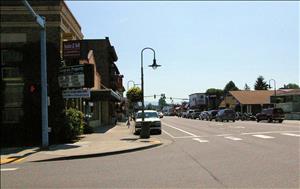On March 19, 1907, Ferndale incorporates. Ferndale is located in Whatcom County, about six miles north of the county seat of Bellingham. The town owes its beginning to impassable log jams which plagued the nearby Nooksack River in the 1860s and 1870s, thus slowing settlement farther north; by the time the jams were cleared in the late 1870s, the little community was coming into its own. In 2007 Ferndale had an estimated population of 11,023.
Logjam the Father of Ferndale
Ferndale got its start almost by accident in 1860, when settler John Tawes, traveling north on the Nooksack River, was forced to land on the banks of the Nooksack because of a massive log jam on the river. Tawes liked what he saw and settled on the spot. Until the late 1870s these logjams often made the site the head of navigation on the Nooksack; Lottie Roeder Roth succinctly writes “It may almost be said that the jam was the father of Ferndale” (History of Whatcom County, p. 818).
The first settler in Ferndale was Billy Clark, who with his Native American wife, Cecelia Chanique, and their children, built a house near the Nooksack River in 1873. Other settlers were also coming into the nascent village by this time, but by the mid-1870s the settlement still had no name, though some informally called it “Jam” because of the notorious log jam on the river nearby.
Then a log schoolhouse opened in the village, and in 1876 its first teacher, Alice Eldridge (1857-1886), renamed the community Ferndale because of the abundance of ferns that grew near the schoolhouse. Eldridge’s timing couldn’t have been better, because in 1876 and 1877 the big log jam on the Nooksack was cleared. Other, smaller jams upriver were cleared through the rest of the 1870s, opening the river to steamer travel and adding impetus to Ferndale’s development.
East and West Reunited
In 1878 A. A. Rogers built a hotel in Ferndale, and was joined by brother Darius (1824?-1897), who built a store and several houses. This formed a trading point for people coming to the area, and by 1880 the Ferndale precinct (which included the area immediately surrounding Ferndale) had a population of 265 and was growing rapidly. Then for a time the town split in two, with a West Ferndale and an East Ferndale on either side of the Nooksack, but eventually the town once again became Ferndale. The telegraph arrived in 1886 and the railroad in 1890 (more than a year before the town built a railroad station), assuring Ferndale’s survival.
Unlike many new towns in Washington state’s history, there seems to have been no particular rush to incorporate Ferndale, which did not officially incorporate until March 19, 1907. Growth was slow in the town for many years. From a population of 691 in 1910, three years after its incorporation, Ferndale grew to 2,164 residents in the 1980 U.S. Census. But growth accelerated dramatically in the final two decades of the twentieth century and this rapid growth has continued into the twenty-first; in 2007, the U.S. Census estimated Ferndale’s population at 11,023.

